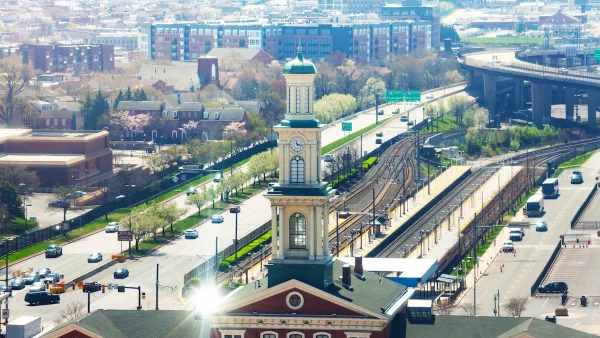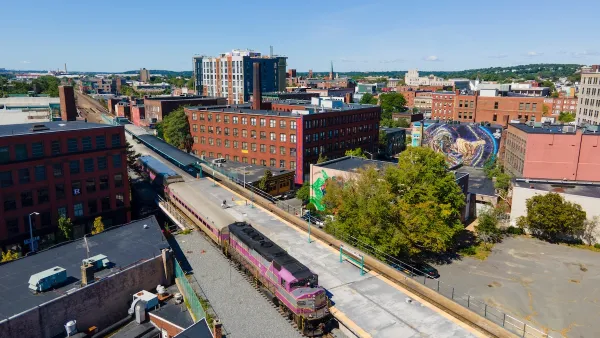You drank the Kool-Aid; you know that if you link transit and land use to create transit-oriented development (TOD) the result is fewer car trips and a host of benefits. From Portland to Miami, Boston to Los Angeles, a record number of TODs are being built in the US. Yet most bankers, developers and regulators are drinking from a different cup. As a result the majority of new development adjacent to transit stops in America has been built in a manner oblivious to the fact that a rail stop is nearby.
You drank the Kool-Aid; you know that if you link transit and land use to create transit-oriented development (TOD) the result is fewer car trips and a host of benefits. From Portland to Miami, Boston to Los Angeles, a record number of TODs are being built in the US. Yet most bankers, developers and regulators are drinking from a different cup. As a result the majority of new development adjacent to transit stops in America has been built in a manner oblivious to the fact that a rail stop is nearby. Therefore many of the hoped for benefits (less time stuck in traffic and lower housing costs to name two) are not being realized from a public investment of nearly $75 billion dollars in rail transit over the past 11 years.
New Research
New research recently completed for the Transit Cooperative Research Program provides the ammunition to build TODs that take the benefits of transit into account. The study completed by PB PlaceMaking, Dr Robert Cervero, The Urban Land Institute and the Center for Transit Oriented Development looked at how automobile use of residential TODs compared to conventional development.
Our research looks at the actual transportation performance of 17 built TOD projects. This was done by counting the passage of motorized vehicles using pneumatic tubes stretched across the driveways of TOD housing projects of varying sizes in four urbanized areas of the country: Philadelphia/N.E. New Jersey; Portland, Oregon; metropolitan Washington D.C.; and the East Bay of the San Francisco Bay Area.
Suburban Bias
One motivation for this research was to provide original and reliable data to help seed new professional guidance for building TODs. In part that means an update of the Institute of Transportation Engineers (ITE) trip generation and parking generation rates, from which local traffic and parking impacts are typically derived and impact fees are set.
Some analysts have identified a serious "suburban bias" in the current ITE rates. Most of the empirical data used to set generation rates are drawn from suburban areas with free and plentiful parking and low-density single land uses. Moreover, since ITE's auto trip reduction factors, to reflect internal trip capture, are based on only a few mixed-use projects in Florida; there has been little or no observation of actual TODs. The end result is that auto trip generation is likely to be overstated for TODs. This can mean that TOD developers end up paying higher impact fees, proffers and exactions than they should since such charges are usually tied to ITE trip rates.
TODs Produce 50% Fewer Trips
In fact, the results of this research clearly show TOD-housing produces fewer automobile trips in the four urbanized areas. The research confirms the ITE trip generation and parking generation rates over estimate automobile trips for TOD housing.
The ITE manual presents "weighted averages" of trip generation that this study showed to be flawed for TODs. The weighted average vehicle trip rates for this study were computed for all 17 projects combined for weekday, AM peak, and PM peak. Over a typical weekday period, the 17 surveyed TOD-housing projects averaged 44% fewer vehicle trips than that estimated by the ITE manual (3.754 versus 6.715 daily trips per unit). The weighted average differentials were even larger during peak periods – 49% lower rates during the A.M. peak and 48% lower rates during the P.M. peak.
Peak hour impact fees and traffic impact studies based on the ITE manual could be overstating the congestion-inducing effects of TOD-housing by as much as 50%. One result may also be unnecessary impact mitigation and roadway improvements. This means that policy makers and planners can "afford" to give TODs as much as 50% lower fees than traditional developments with no adverse effects on other areas of government budgets caused by traffic impacts.
New Standards Needed to Reflect Reality
Existing suburban standards assume virtually everyone drives. It should now be indisputable: TODs perform differently than conventional development. New parking and trip generation rates are necessary to reflect reality. Implementing the findings of this research will allow communities across America to capture the benefits of TOD and reap additional benefits from the substantial investment in transit.
New standards could result in wholesale changes in how we address the cost, impact and feasibility of residential development near transit. The implications of new standards are varied:
- Local officials and neighborhoods may be more apt to support increases in residential densities near transit if they are shown proof significantly fewer trips result from TODs than in conventional development.
- Developers would likely pay lower fees and extractions by as much as 50% to reflect the actual performance of residential TODs. Those savings can be passed on to consumers in the form of lower housing costs.
- Parking availability and cost has a major impact on transit use. Transit agencies should plan for increased ridership from lower parking ratios for residential TODs.
- Housing affordability is a crisis facing the nation. More affordable TOD housing should be available to the public because of lower development costs and the need for less expensive parking.
- More compact environmentally sustainable development can result from less land being consumed for parking. U.S. EPA estimates each on-site parking space in infill locations can reduce the number of new housing units or other uses by 25 percent or more.
Implementing these findings should help result in better planned communities, less time stuck in traffic and more affordable housing. Let's get going.
Appendix: Snapshot from the study
All 17 projects studies were within an easy walk of high quality transit with a mix of modes – heavy rail, commuter rail and light rail. Projects ranged in size from 90 to 854 units. The primary use was residential though 6 of the 17 sites had incidental retail uses on the first floor.
Washington, D.C. - 59.9% below ITE A.M. peak rate The biggest effects were found in the Washington, D.C. metropolitan area. Among the five mid-to-high rise apartment projects near Metrorail stations outside the District of Columbia, vehicle trip generation rates were more than 60% below that predicted by the ITE manual.
Portland, OR – 49.63% below ITE A.M. peak rate After the Washington area, TOD-housing in the Portland area tended to have the lowest weekday trip generation rates – on average, around 40% below that predicted by the ITE manual. The Portland projects which performed best were those on the fringes of the City Center. Collins Circle on the western edge of downtown produced trip rates 78% below those predicted in the ITE manual.
San Francisco Bay Area – 47.5% below ITE A.M. peak rate The San Francisco Bay Area also averaged vehicle trip generation rates substantially below those estimated by the ITE manual. Among the East Bay TOD-housing projects studied, Montelena Homes had the lowest weekday rate: 2.46 trip ends per dwelling unit, 63% below ITE's rate.
Philadelphia / Newark – 30.53% below ITE A.M. peak rate Lastly, the two apartment projects near suburban commuter rail stations outside of Philadelphia and the Newark metropolitan area of northeast New Jersey averaged weekday vehicle trip generation rates that were roughly one-quarter less than that predicted by the ITE manual. This is an appreciable difference given the relatively low-density settings of these projects and that commuter rail offers limited midday and late-night services.

Planetizen Federal Action Tracker
A weekly monitor of how Trump’s orders and actions are impacting planners and planning in America.

Map: Where Senate Republicans Want to Sell Your Public Lands
For public land advocates, the Senate Republicans’ proposal to sell millions of acres of public land in the West is “the biggest fight of their careers.”

Restaurant Patios Were a Pandemic Win — Why Were They so Hard to Keep?
Social distancing requirements and changes in travel patterns prompted cities to pilot new uses for street and sidewalk space. Then it got complicated.

Platform Pilsner: Vancouver Transit Agency Releases... a Beer?
TransLink will receive a portion of every sale of the four-pack.

Toronto Weighs Cheaper Transit, Parking Hikes for Major Events
Special event rates would take effect during large festivals, sports games and concerts to ‘discourage driving, manage congestion and free up space for transit.”

Berlin to Consider Car-Free Zone Larger Than Manhattan
The area bound by the 22-mile Ringbahn would still allow 12 uses of a private automobile per year per person, and several other exemptions.
Urban Design for Planners 1: Software Tools
This six-course series explores essential urban design concepts using open source software and equips planners with the tools they need to participate fully in the urban design process.
Planning for Universal Design
Learn the tools for implementing Universal Design in planning regulations.
Heyer Gruel & Associates PA
JM Goldson LLC
Custer County Colorado
City of Camden Redevelopment Agency
City of Astoria
Transportation Research & Education Center (TREC) at Portland State University
Camden Redevelopment Agency
City of Claremont
Municipality of Princeton (NJ)





























